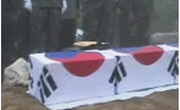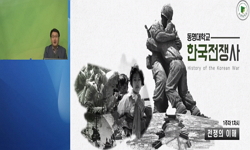Golryeonggol, l oc ated i n southeastern Daejeon n ear Okc heon a nd Geumsan, is the site of a civilian massacre during the Korean War. In 1950, following the war’s outbreak, South Korean military and police forces executed prisoners from the Daejeo...
http://chineseinput.net/에서 pinyin(병음)방식으로 중국어를 변환할 수 있습니다.
변환된 중국어를 복사하여 사용하시면 됩니다.
- 中文 을 입력하시려면 zhongwen을 입력하시고 space를누르시면됩니다.
- 北京 을 입력하시려면 beijing을 입력하시고 space를 누르시면 됩니다.

유해의 물질성과 기억의 정치: 한국전쟁기 대전 골령골 민간인학살지 유해발굴 사례 연구 = Materiality of Human Remains and Politics of Memory: A Study of Exhumation at ‘Golryeonggol’, the Site of a Korean War Civilian Massacre
한글로보기https://www.riss.kr/link?id=A109432480
-
저자
김태인 (한양대학교)
- 발행기관
- 학술지명
- 권호사항
-
발행연도
2024
-
작성언어
Korean
-
주제어
기억의 정치 ; 전쟁 기억 ; 한국전쟁 ; 민간인학살 ; 유해발굴 ; 물질성 ; 골령골 ; Politics of Memory ; War Memory ; Korean War ; Civilian Massacre ; Exhumation ; Materiality ; Golryeonggol
-
등재정보
KCI등재
-
자료형태
학술저널
-
수록면
93-132(40쪽)
- 제공처
-
0
상세조회 -
0
다운로드
부가정보
다국어 초록 (Multilingual Abstract)
In this paper I critique the manner of the exhumations and the operation of the historical fact-finding movement at Golyeonggol, by focusing on the materiality of the victims’ remains. I argue that these remains should not be seen as fixed entities, but as materials embodying fluidity and complexity. In the context of the discovery and preservation of the burial sites, the repeated exhumations, and the circumstances that followed, the victims’ remains are viewed both as sacred figures—symbolically “fathers and mothers”—and as unstable materials that blur the line between human and non-human. This instability creates tensions in the evolving expectations of bereaved families, civil society, and the external performance of the fact-finding movement at Golryeonggol. By recalling the material conditions of the remains and the gaps in memory politics at Golryeonggol, I argue that exhumations and fact-finding movements at Golryeonggol and other civilian massacre sites should be approached with greater reflection in the future.
Golryeonggol, l oc ated i n southeastern Daejeon n ear Okc heon a nd Geumsan, is the site of a civilian massacre during the Korean War. In 1950, following the war’s outbreak, South Korean military and police forces executed prisoners from the Daejeon Prison, members of the National Security and Directive League, and those suspected of collaborating with the People’s Army. In the late 1990s with the conclusion of the Cold War, local civil society groups and organizations representing bereaved family members initiated campaigns to uncover the truth. T hese e fforts led t o five e xc avations whic h took plac e between 2007 and 2022, uncovering the remains of over 1,400 victims.
In this paper I critique the manner of the exhumations and the operation of the historical fact-finding movement at Golyeonggol, by focusing on the materiality of the victims’ remains. I argue that these remains should not be seen as fixed entities, but as materials embodying fluidity and complexity. In the context of the discovery and preservation of the burial sites, the repeated exhumations, and the circumstances that followed, the victims’ remains are viewed both as sacred figures—symbolically “fathers and mothers”—and as unstable materials that blur the line between human and non-human. This instability creates tensions in the evolving expectations of bereaved families, civil society, and the external performance of the fact-finding movement at Golryeonggol. By recalling the material conditions of the remains and the gaps in memory politics at Golryeonggol, I argue that exhumations and fact-finding movements at Golryeonggol and other civilian massacre sites should be approached with greater reflection in the future.
국문 초록 (Abstract)
본 연구는 ‘피학살자 유해’를 중심으로 물질과 신체의 관점에서 대전 골령골의 과거사운동과 유해발굴 현장을 기술 및 비평한다. 그 전제로서 본고는 피학살자 유해가 고정된 실체가 아니라 상시 유동성ㆍ다면성을 내포한 물질이라는 점에 주목한다. 유해매장지의 발견과 보존, 거듭된 발굴과 그 이후의 구체적 상황 속에서 유해는 해원이 필요한 ‘아버지, 어머니’로서 신성시되는 한편, 인간과 비인간 사이의 물질적 조건을 수시로드러낸다. 발굴 중, 그리고 발굴 종료 후 나타나는 유해의 불안정한 물질성은 골령골과거사운동 내 유가족 및 시민사회의 갱신된 과제와 기대, 운동의 대외적 성과에 균열을 낸다. 본고는 피학살자 유해의 물질적 조건과 골령골 기억 정치 내의 간극을 상기하며 향후 더욱 성찰적 태도로 골령골과 전국 민간인학살 현장의 과거사운동과 유해발굴이 전개되어야 한다고 논한다.
대전의 동남부, 옥천과 금산에 접한 외곽 지대엔 골령골이라는 한국전쟁기 민간인학살지가 있다. 1950년 한국전쟁 발발 직후, 대전형무소 재소자와 국민보도연맹원, 인민군 부역혐의자가 남...
대전의 동남부, 옥천과 금산에 접한 외곽 지대엔 골령골이라는 한국전쟁기 민간인학살지가 있다. 1950년 한국전쟁 발발 직후, 대전형무소 재소자와 국민보도연맹원, 인민군 부역혐의자가 남한 군경에 의해 이곳에서 학살되었다. 골령골은 냉전기를 지나1990년대 말부터 지역 시민사회와 유족회의 과거사 진상규명 운동으로 점차 사람들에게 알려지기 시작했다. 운동의 결실로서 2007년부터 2022년 사이 5차시의 유해발굴이이루어져 1,400명 이상의 유해가 출토되었다.
본 연구는 ‘피학살자 유해’를 중심으로 물질과 신체의 관점에서 대전 골령골의 과거사운동과 유해발굴 현장을 기술 및 비평한다. 그 전제로서 본고는 피학살자 유해가 고정된 실체가 아니라 상시 유동성ㆍ다면성을 내포한 물질이라는 점에 주목한다. 유해매장지의 발견과 보존, 거듭된 발굴과 그 이후의 구체적 상황 속에서 유해는 해원이 필요한 ‘아버지, 어머니’로서 신성시되는 한편, 인간과 비인간 사이의 물질적 조건을 수시로드러낸다. 발굴 중, 그리고 발굴 종료 후 나타나는 유해의 불안정한 물질성은 골령골과거사운동 내 유가족 및 시민사회의 갱신된 과제와 기대, 운동의 대외적 성과에 균열을 낸다. 본고는 피학살자 유해의 물질적 조건과 골령골 기억 정치 내의 간극을 상기하며 향후 더욱 성찰적 태도로 골령골과 전국 민간인학살 현장의 과거사운동과 유해발굴이 전개되어야 한다고 논한다.
동일학술지(권/호) 다른 논문
-
불안한 노년: 중국 실버타운의 위기로 보는 시장화된 돌봄 체계의 한계
- 한국문화인류학회
- 박여리
- 2024
- KCI등재
-
- 한국문화인류학회
- 박현귀
- 2024
- KCI등재
-
도덕의 상품화: AI 도입 이후 콜센터 감정노동의 지형변화
- 한국문화인류학회
- 김관욱
- 2024
- KCI등재
-
Exploring Sensory Anthropology: Development, Limitations, and Its Introduction to Korea
- 한국문화인류학회
- 김재영
- 2024
- KCI등재




 KISS
KISS






